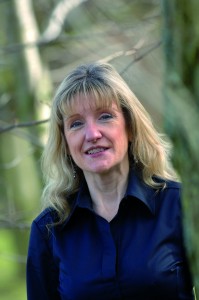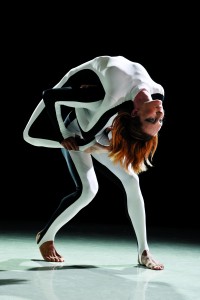MONDAY, 4 JANUARY 2010
As academics we are by definition specialists. With sharp skills, wise decision-making and right-place-right-time luck, we find a position within our chosen niche. And so our specialism becomes even more defined, like an ID tag on our careers.But what happens if we have two specialisms? The typical route would be to concentrate on one whilst the other nestles in the wings. Nicky Clayton, professor of comparative cognition at the Department of Experimental Psychology and an accomplished dancer, has managed to blend her two passions in her current role as scientific advisor to the Rambert Dance Company.
Nicky’s day job focuses on social and physical cognition in corvids (rooks, jackdaws, and jays), as well as on the memory and executive skills of other bird families and apes. By night she dances, teaching tango and salsa, and still takes the occasional class in ballet and a weekly jazz workout. Her work with Rambert weaves together her previously separate lives into a tailor-made position.
Nicky’s dual roles are evident in her office, where richly coloured dance photographs bookend heavy psychology volumes. As she explains aspects of avian behaviour, she rises to illustrate her points. Within minutes, you can see the scientist as choreographer and the choreographer as scientist. Through talking to Nicky, you see how working at the frontiers of both science and the arts can create something useful, something beautiful, and can highlight parallels that smash the traditional arts versus science dichotomy.
Rambert is not the only dance company to seek the expertise of academics. The British company Random Dance works with Philip Barnard, of the Cognition and Brain Sciences Unit here in Cambridge, on synergies between choreographic processes and knowledge of cognitive neuroscience. So why should dance companies need scientific advisors? Dance productions draw inspiration from here and there – folk tales and mythology, historical events, great works of literature. Nature is a common theme, and there lies the need for an advisor who can explain precisely how a swan glides around a lake or (with some creative input) how a mouse king does battle.
Rambert’s latest project is The Comedy of Change, inspired by Darwin’s theories of natural and sexual selection. Through a hawk-eyed sensitivity for opportunity and an instant connection with Mark Baldwin, artistic director of the company and choreographer of Comedy, Nicky has become deeply involved with the production. As she talks about the development of the show, she explains how the artistic collaboration differs from the way teamwork unfolds in her scientific life.
“There are a lot more people involved,” she says, indicating the many facets in transforming a creative concept into a full stage production. Coupled with a more fluid structure than most university research teams, this means that Nicky’s roles are many and varied. From educational outreach, to working with the dancers and animateurs, liaising with financial backers and giving talks at the production, “the work feels a lot more diverse and a lot more outward-facing than typical scientific collaborations.”
Alongside the expected contrasts, there are many shared aspects between the artistic and scientific processes. Nicky points out that both animal cognition and dance share the challenge of conveying beautiful ideas and thoughts in the absence of language. Both Nicky, as professor of comparative cognition, and Baldwin, as world class choreographer, tease this out by capitalising on movement; “The main difference is that my subjects have feathers and no hands,” Nicky adds. Where the choreographer deliberates over which movements are appropriate, the professor debates which tests are best for the job in hand. There are also parallels in the relationship between the subjects and the audience; “Choreographers create something for the audience’s pleasure, but it couldn’t possibly work if the dancers weren’t comfortable with the moves. As a scientist, I have to convince the readership that my experiments are well designed and my claims are realistic, but none of that would happen without the cooperation of the birds.”
One of the principal dancers in The Comedy of Change illustrates the overlap with stunning directness; his head and neck movements mimic the courtship dance of one of the six-plumed birds of paradise. In the forests of New Guinea, and now in British theatres, the male clears his dance space of all the leaves, rises up on his toes, and shimmies across the stage. The male with the best dance and the funkiest head movements not only gets the girl, but also the solo.
So how can dry old science ever compete with the arts for space in the public psyche? As a quick measure, a Google search for scientists Colin Blakemore or Jocelyn Bell Burnell throws up about 30,000 websites. Do the same for Michael Jackson and we get 4,000 times that amount. As much as Blakemore and Bell Burnell are big news in science, they don’t touch the everyday collective consciousness.
What Nicky is really championing is the idea that the arts really can fling open the doors to science. This year in Cambridge, we have had Darwinian music, painting, comedy, and even cookery. The Comedy of Change is the latest example of the arts popularising science. I ask Nicky whether audiences come to be educated as well as entertained. Her answer underlines the subtlety with which the production conveys the science; “Only if they want to be. First and foremost, Mark’s beautiful choreography is for the audience’s pleasure, but hopefully there might be a few ideas that might inspire.” Nicky goes on, characteristically drawing biological analogies; “Our aim is not to educate the public about Darwin’s ideas, it’s about sowing a few seeds. If the public wish to let those ideas germinate, then that will inspire them about Darwin.” Clearly, the project is not a scientific mission, but a means of exposing the public to ideas about life on earth.
Eminent professor, self-confessed bird-nerd and committed dancer, Nicky attributes her enviable energy levels to good maternal genes and a supportive husband; “I recharge by dancing. I’m doing something different. My brain isn’t thinking about science, it’s busy concentrating on something else so it gets a good rest and a break from the science.”
As a schoolgirl, Nicky’s reports warned that she “could do very well as long as she doesn’t burn herself out”. It seems unlikely. From blazing trails in academia to burning up dance floors, the researcher and dancer goes on creating. Like nature’s most harmonious symbioses, such ventures between the disciplines strengthen and nourish the other to ensure continued growth and survival.
The Comedy of Change continues its tour of the UK until 30 April 2010
Cat Davies is a PhD student in the Research Centre for English and Applied Linguistics.



